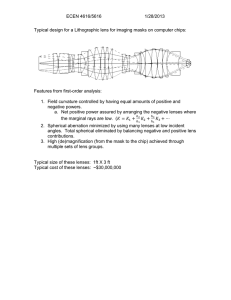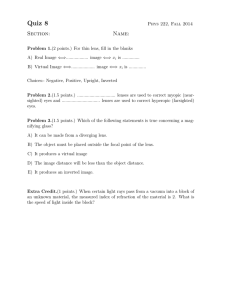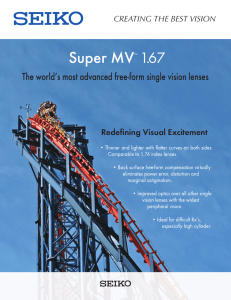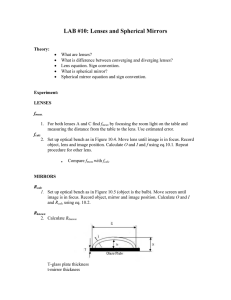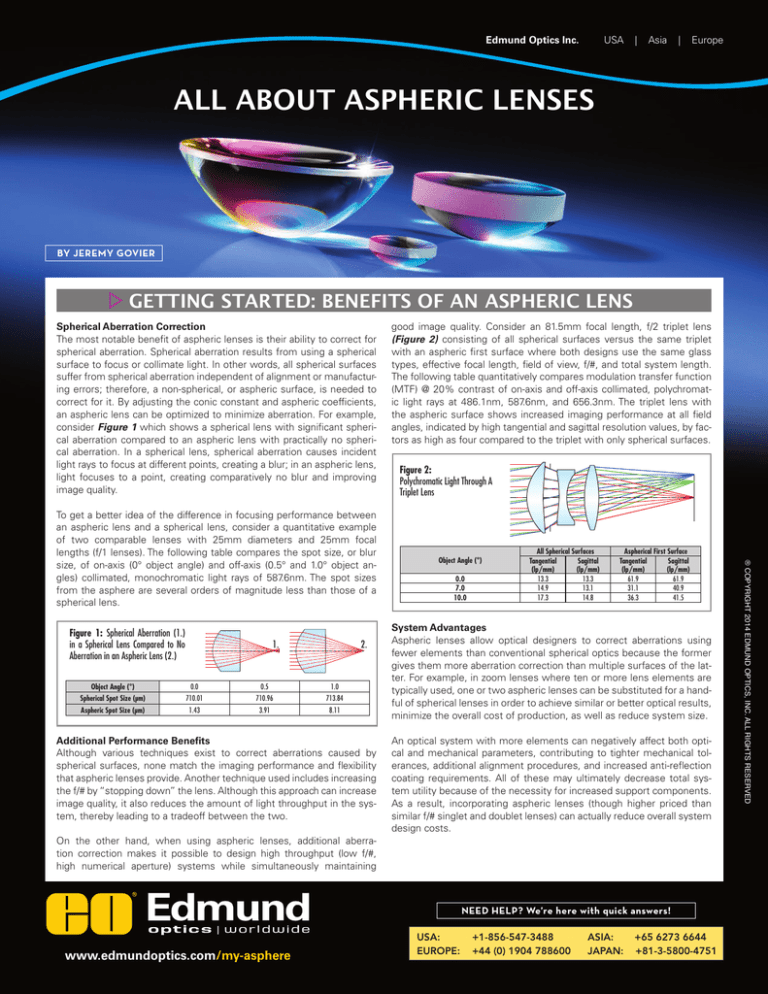
USA
Edmund Optics Inc.
|
Asia
|
Europe
ALL ABOUT ASPHERIC LENSES
BY JEREMY GOVIER
GETTING STARTED: BENEFITS OF AN ASPHERIC LENS
Spherical Aberration Correction
The most notable benefit of aspheric lenses is their ability to correct for
spherical aberration. Spherical aberration results from using a spherical
surface to focus or collimate light. In other words, all spherical surfaces
suffer from spherical aberration independent of alignment or manufacturing errors; therefore, a non-spherical, or aspheric surface, is needed to
correct for it. By adjusting the conic constant and aspheric coefficients,
an aspheric lens can be optimized to minimize aberration. For example,
consider Figure 1 which shows a spherical lens with significant spherical aberration compared to an aspheric lens with practically no spherical aberration. In a spherical lens, spherical aberration causes incident
light rays to focus at different points, creating a blur; in an aspheric lens,
light focuses to a point, creating comparatively no blur and improving
image quality.
Figure 1: Spherical Aberration (1.)
in a Spherical Lens Compared to No
Aberration in an Aspheric Lens (2.)
1.
2.
Object Angle (°)
0.0
0.5
1.0
Spherical Spot Size (µm)
710.01
710.96
713.84
Aspheric Spot Size (µm)
1.43
3.91
8.11
Additional Performance Benefits
Although various techniques exist to correct aberrations caused by
spherical surfaces, none match the imaging performance and flexibility
that aspheric lenses provide. Another technique used includes increasing
the f/# by “stopping down” the lens. Although this approach can increase
image quality, it also reduces the amount of light throughput in the system, thereby leading to a tradeoff between the two.
Figure 2:
Polychromatic Light Through A
Triplet Lens
Object Angle (°)
0.0
7.0
10.0
All Spherical Surfaces
Tangential
Sagittal
(lp/mm)
(lp/mm)
13.3
13.3
14.9
13.1
17.3
14.8
Aspherical First Surface
Tangential
Sagittal
(lp/mm)
(lp/mm)
61.9
61.9
31.1
40.9
36.3
41.5
System Advantages
Aspheric lenses allow optical designers to correct aberrations using
fewer elements than conventional spherical optics because the former
gives them more aberration correction than multiple surfaces of the latter. For example, in zoom lenses where ten or more lens elements are
typically used, one or two aspheric lenses can be substituted for a handful of spherical lenses in order to achieve similar or better optical results,
minimize the overall cost of production, as well as reduce system size.
An optical system with more elements can negatively affect both optical and mechanical parameters, contributing to tighter mechanical tolerances, additional alignment procedures, and increased anti-reflection
coating requirements. All of these may ultimately decrease total system utility because of the necessity for increased support components.
As a result, incorporating aspheric lenses (though higher priced than
similar f/# singlet and doublet lenses) can actually reduce overall system
design costs.
On the other hand, when using aspheric lenses, additional aberration correction makes it possible to design high throughput (low f/#,
high numerical aperture) systems while simultaneously maintaining
NEED HELP? We’re here with quick answers!
www.edmundoptics.com/my-asphere
USA: EUROPE:
+1-856-547-3488
+44 (0) 1904 788600
ASIA:
JAPAN:
+65 6273 6644
+81-3-5800-4751
® COPYRIGHT 2014 EDMUND OPTICS, INC. ALL RIGHTS RESERVED
To get a better idea of the difference in focusing performance between
an aspheric lens and a spherical lens, consider a quantitative example
of two comparable lenses with 25mm diameters and 25mm focal
lengths (f/1 lenses). The following table compares the spot size, or blur
size, of on-axis (0° object angle) and off-axis (0.5° and 1.0° object angles) collimated, monochromatic light rays of 587.6nm. The spot sizes
from the asphere are several orders of magnitude less than those of a
spherical lens.
good image quality. Consider an 81.5mm focal length, f/2 triplet lens
(Figure 2) consisting of all spherical surfaces versus the same triplet
with an aspheric first surface where both designs use the same glass
types, effective focal length, field of view, f/#, and total system length.
The following table quantitatively compares modulation transfer function
(MTF) @ 20% contrast of on-axis and off-axis collimated, polychromatic light rays at 486.1nm, 587.6nm, and 656.3nm. The triplet lens with
the aspheric surface shows increased imaging performance at all field
angles, indicated by high tangential and sagittal resolution values, by factors as high as four compared to the triplet with only spherical surfaces.
USA
Edmund Optics Inc.
|
Asia
|
Europe
ANATOMY OF AN ASPHERIC LENS
The term asphere encompasses anything that is not a portion of a
sphere, however when we use the term here we are specifically talking about the subset of aspheres that are rotationally symmetric optics
with a radius of curvature that varies radially from the center of the lens.
Aspheric lenses improve image quality, reduce the number of required
elements, and lower costs in optical designs. From digital cameras and
CD players to high-end microscope objectives and fluorescence microscopes, aspheric lenses are growing into every facet of the optics, imaging, and photonics industries due to the distinct advantages that they
offer compared to traditional spherical optics.
Aspheric lenses have been traditionally defined with the surface profile
(sag) given by Equation 1:
(1)
Z(s)=
Cs2
+A4s4+A6s6+A8s8+...
1+√1-(1+k)C2s2
Where:
Z = sag of surface parallel to the optical axis
s = radial distance from the optical axis
C = curvature, inverse of radius
k = conic constant
A4, A6, A8...= 4th, 6th, 8th… order aspheric terms
Conic Constant
k=0
k>-1
k=-1
k<-1
Conic Surface
Sphere
Ellipse
Parabola
Hyperbola
The most unique geometric feature of aspheric lenses is that the radius of curvature changes with distance from the optical axis, unlike a
sphere, which has a constant radius (Figure 3). This distinctive shape allows aspheric lenses to deliver improved optical performance compared
to standard spherical surfaces.
Figure 3:
Comparison of Spherical and Aspheric
Surface Profiles
Asphere
Sphere
Over the past few years, two other definitions that use orthogonal
terms have gained in popularity called Q-type aspheres. These Q-type
aspheres, Qcon and Qbfs allow designers more control over the optimization of the aspheres by using orthogonal coefficients and generally
reduce the terms needed for manufacturing the asphere.
HOW ARE THEY MADE? TYPES OF ASPHERES
PRECISION GLASS MOLDING
Precision glass molding uses a manufacturing technique where optical
glass cores are heated to high temperature until the surface becomes
malleable enough to be pressed into an aspheric mold (Figure 4). After
cooling the cores to room temperature, they maintain the shape of the
mold. Creating the mold has high initial startup costs because it has to
be precisely made from very durable material that can maintain a smooth
surface and take into account any shrinkage of the glass cores in order to
yield the desired aspheric shape. However, once the mold is finished, the
incremental cost for each lens is lower than that of standard manufacturing techniques, making it a great option for high volume production.
Figure 4: Precision Glass Molding Platform
Cooling Plate
Die Holder
Cores
HOW ARE THEY MADE? TYPES OF ASPHERES
Mold Base
Die Holder
NEED HELP? Asphere experts standing by!
www.edmundoptics.com/my-asphere
USA: EUROPE:
+1-856-547-3488
+44 (0) 1904 788600
ASIA:
JAPAN:
+65 6273 6644
+81-3-5800-4751
® COPYRIGHT 2014 EDMUND OPTICS, INC. ALL RIGHTS RESERVED
When the aspheric coefficients are equal to zero, the resulting aspheric
surface is considered to be a conic. The following table shows how the
actual conic surface generated depends on the magnitude and sign of
the conic constant, k.
Edmund Optics Inc.
USA
|
Asia
|
Europe
HOW ARE THEY MADE? TYPES OF ASPHERES (CONTINUED)
PRECISION POLISHING
For a number of years, machined aspheric lenses have been ground and polished one lens at a time. Although this process of individually producing machined aspheres hasn’t changed dramatically, significant fabrication technology
advancements have recently elevated the achievable level of accuracy possible
from this production technique. Most notably, computer controlled precision
polishing (Figure 5) automatically adjusts the tool dwell parameters to polish
away high spots where more polishing is needed. If higher quality polishing is
required, magneto-rheological finishing (MRF) is used to perfect the surface
(Figure 6). MRF technology provides high performance finishing in less time
than standard polishing techniques because of its precise control of the removal
location and high removal rate. While other manufacturing techniques generally
require a special mold, unique to each lens, polishing utilizes standard tooling
which makes it the primary option for prototyping and low volume production.
Figure 5:
Computer Controlled Precision Polishing
Figure 6:
Magneto-Rheological Finishing (MRF)
HYBRID MOLDING
Hybrid molding begins with a standard spherical surface, such as an achromatic lens, which is then pressed onto a thin layer of photopolymer in an
aspheric mold to give the net result of an aspheric surface. The technique
uses a diamond ground aspheric mold and a glass achromatic lens (though
other types of singlet or doublet lenses can be used). A photopolymer is
introduced into the aspheric mold, against which the achromatic lens is
pressed. The two surfaces are compressed and UV cured at room temperature to yield an aspherized achromatic lens that combines the desired optical properties of the constituent parts: chromatic and spherical aberration
correction. Figure 7 illustrates the process of creating a hybrid lens. Hybrid
molding is useful for high volume precision applications where additional
performance is required and the quantity can justify the initial tooling costs.
Figure 7: Hybrid Molding Technique
Photopolymer Introduction
Diamond Ground Aspheric Mold & Achromat
Achromat Compression & UV Curing
Finished Aspherized Achromat
In addition to the aforementioned manufacturing techniques for
glass, there exists one unique technique for plastic. Plastic molding
involves injecting molten plastic into an aspheric mold. Since plastic is not as thermally stable and resistant to pressure as glass, it
has to be treated specially in order to create a usable aspheric lens.
Nevertheless, plastic is advantageous because it is light-weight, easily molded, and can be integrated with a mount to create a single
element. While the selection of optical quality plastic is limited, the
cost and weight benefits sometimes drive designs toward plastic
aspheric lenses.
ADVANTAGES FOR EACH TYPE OF ASPHERE
Since all applications do not require identical lens performance, selecting the
appropriate aspheric lenses is an important decision. Key factors to consider
include your project timeline, overall performance requirements, budgetary
constraints, and anticipated volumes.
Many applications may be completely satisfied with an off-the-shelf aspher-
ic lens, taking advantage of the immediate availability and straightforward
order fulfillment. Often, these standard aspheric lenses can also be quickly
and easily modified with anti-reflection coatings or dimensional reduction to
address requirements that are reasonably close to the standard offering. If
off-the-shelf products are not sufficient, consider custom aspheric manufacturing for prototype, pre-production, or large volume applications.
Type
Benefit
Precision Glass Molded
Ideal for high volume production requirements because of rapid production of many lenses and low tooling upkeep costs.
Precision Polished
Ideal for prototype or low volume requirements because of short lead time, minimum special tooling setup
Hybrid Molded
Ideal for multi-spectral applications because of correction for both spherical and chromatic aberration.
Plastic Molded
Ideal for volume production as a weight-sensitive, low cost alternative to glass aspheric lenses.
NEED HELP? Contact us now!
www.edmundoptics.com/my-asphere
USA: EUROPE:
+1-856-547-3488
+44 (0) 1904 788600
ASIA:
JAPAN:
+65 6273 6644
+81-3-5800-4751
® COPYRIGHT 2014 EDMUND OPTICS, INC. ALL RIGHTS RESERVED
PLASTIC MOLDING
Edmund Optics Inc.
USA
|
Asia
|
Europe
CUSTOM ASPHERIC MANUFACTURING CAPABILITIES
Commercial
Precision
High Precision
Diameter
10 - 150mm
10 - 150mm
10 - 150mm
Metrology
Profilometry
Profilometry
Interferometry
Asphere Figure Error (P - V)
±5μm
±1μm
±0.25μm
Vertex Radius (Asphere)
±1%
±0.1%
±0.05%
Radius (Spherical)
±0.5%
±0.1%
±0.025%
Power (Spherical)
2λ
1/2λ
1/10λ
Irregularity (Spherical)
1/2λ
1/4λ
1/20λ
Centering (Beam Deviation)
3 arcmin
1 arcmin
0.5 arcmin
Center Thickness Tolerance
±0.100mm
±0.050mm
±0.010mm
Diameter Tolerance
+0/-0.050mm
+0/-0.025mm
+0/-0.010mm
Surface Quality
80-50
60-40
20-10
Bevel
0.5mm Max Face Width @ 45°
0.2mm Max Face Width @ 45°
0.1mm Max Face Width @ 45°
ASPHERIC LENS SELECTION GUIDE
Precision Polished Aspheric Lenses
Precision polished aspheric lenses are ideal for the most demanding applications. Designed to offer high numerical apertures while
creating diffraction-limited spot sizes.
•Available in UV, Visible, and IR Grade Materials
•Variety of Standard Coating Options Available
•Full Prescription Data for Easy Integration into OEM Applications
Precision Molded Aspheric Lenses
Precision molded aspheric lenses are ideal for volume applications, including laser diode collimation, bar code scanners, and
optical data storage.
•Micro-sized Aspheres (2-10mm Diameters)
•Variety of Standard Coating Options Available
•Available in Glass and Plastic Substrates
From small molded aspheres for use with MWIR quantum
cascade lasers, to families of germanium and zinc selenide
aspheres, we offer solutions for the entire infrared spectrum.
•Available in Diameters from 5.5 - 50.8mm
•Hybrid Designs Available for Improved
Broadband Performance
•Variety of Coating Options Available
Stock Products:
• TECHSPEC® Germanium and Hybrid Germanium Aspheric Lenses
•Zinc Selenide Aspheric Lenses
•Mid and Long Wave Infrared Aspheric Lenses
•IG6 Aspheric Lenses
HOW CAN I DESIGN YOUR NEXT
PROJECT TO MEET BUDGET,
PERFORMANCE, AND SCHEDULE
REQUIREMENTS?
Stock Products:
•Precision Molded Aspheric Lenses
•Mid and Long Wave Infrared Aspheric Lenses
• TECHSPEC® Plastic Hybrid Aspheric Lenses
•TECHSPEC® Plastic Aspheric Lenses
– Jeremy Govier
Aspheric Lens Guru
Color-Corrected Aspheric Lenses
We offer several unique families of aspheric lenses, designed
to provide both spherical and chromatic aberration correction.
These families are ideal for applications requiring near-diffraction limited focusing performance over a range of wavelengths. •Aspherized Achromats Combine Glass Achromat with
Plastic Asphere
•Hybrid Aspheres Combine Refractive and Diffractive Properties
Call or e-mail today!
+1-856-547-3488
Stock Products:
•TECHSPEC® Aspherized Achromatic Lenses
•TECHSPEC® Plastic Hybrid Aspheric Lenses
•TECHSPEC® Hybrid Germanium Aspheric Lenses
asphere@edmundoptics.com
Let’s get started today!
www.edmundoptics.com/my-asphere
USA: EUROPE:
+1-856-547-3488
+44 (0) 1904 788600
ASIA:
JAPAN:
+65 6273 6644
+81-3-5800-4751
® COPYRIGHT 2014 EDMUND OPTICS, INC. ALL RIGHTS RESERVED
Stock Products:
•TECHSPEC® Calibration Grade Aspheric Lenses
•TECHSPEC® Precision Aspheric Lenses
• TECHSPEC® UV-Grade Fused Silica Precision Aspheric Lenses
infrared Aspheric Lenses

